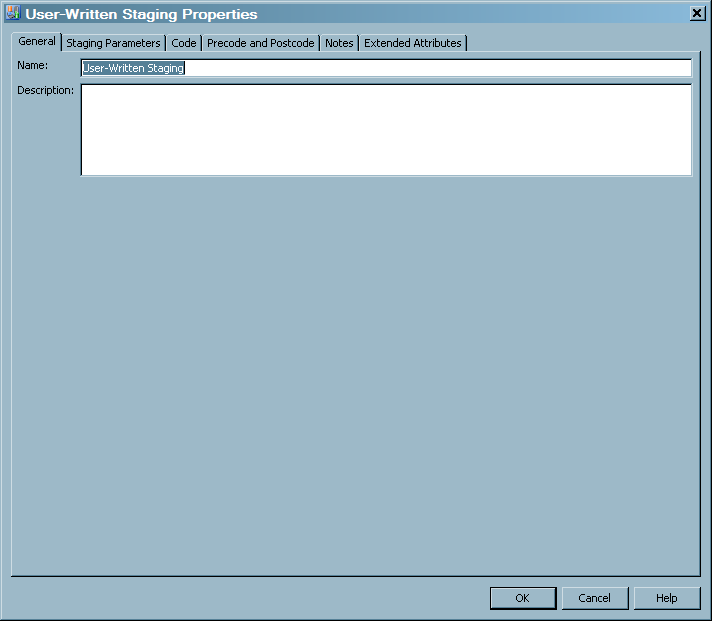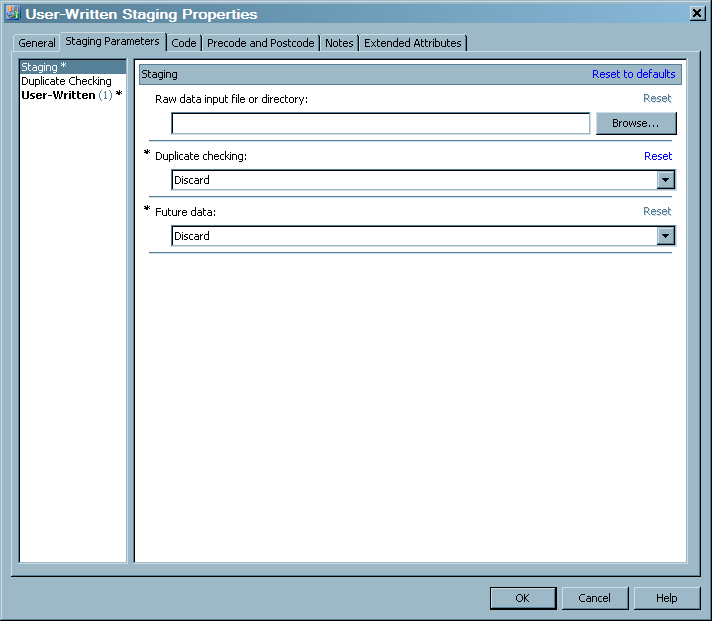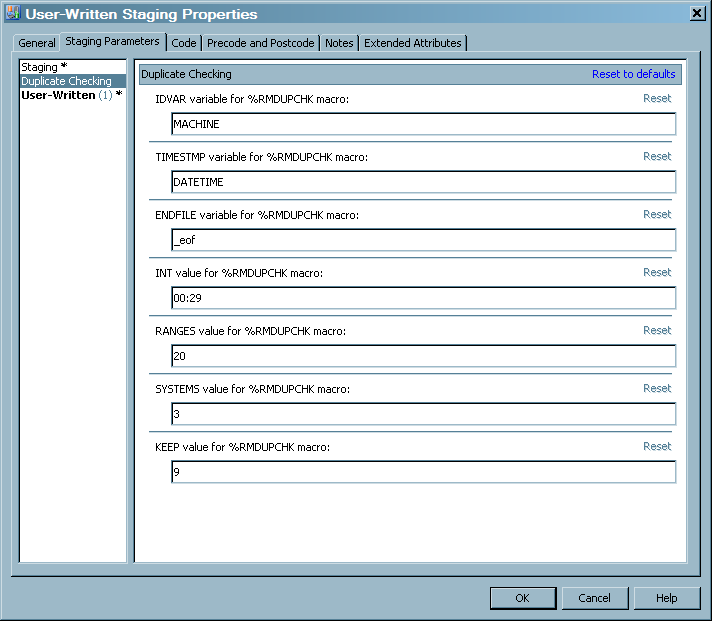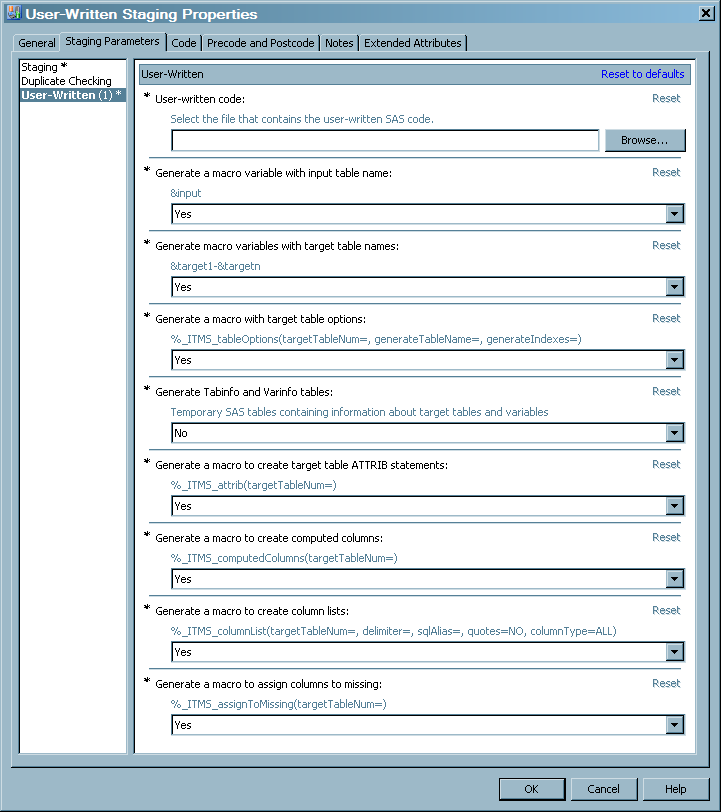Working with User-Written Staging Transformations
Create a User-Written Staging Transformation
-
To create a table, select File
 New
New Table to open the New Table wizard.
Respond to the prompts as needed and click Finish. To attach the new table to the transformation, navigate to the
location of the table in the tree where you stored its metadata. Drag
and drop the table onto the process flow diagram and attach the table
to the transformation.
Table to open the New Table wizard.
Respond to the prompts as needed and click Finish. To attach the new table to the transformation, navigate to the
location of the table in the tree where you stored its metadata. Drag
and drop the table onto the process flow diagram and attach the table
to the transformation.
-
Attach a target table to the transformation. (Multiple target tables can be attached to the transformation.)TipIf you cannot attach the table to the transformation, right-click the transformation and from the menu that is displayed, select Connections. In the User Written Staging Connections dialog box that opens, the Output Node field of the target table should have a value. If the field does not have a value (or displays
<none>), double-click the ellipsis (...) in the Output Node field and select the table to which you want to connect. Then click OK. Click OK again to return to the process flow diagram and connect the target table to the transformation. -
In the Name field on the General tab, enter the name of the transformation if you do not want to retain the default name. The name of the transformation can be no more than 60 characters. This field cannot be blank.
-
-
You can specify the following information:
-
In the Raw data input file or directory field, enter the location of the file or directory that contains the raw data that is input to your staging transformation.Click Browse to open the Select the File or Directory dialog box. In the Look in field, the drop-down list displays the files and directories that are available in the metadata repository to which you are connected. From the drop-down list that is displayed, select the file or directory that contains the raw data that is input to your user-written staging transformation.For information about the Raw data input file or directory parameter, see Choose Raw Data Input Type.
-
In the Duplicate Checking field, the drop-down list displays the options that are available for handling duplicate-data checking. These options are Discard, Force, Inactive, and Terminate. Select the option that you want to use, or use the default value, Discard.For information about the Duplicate Checking parameter, see Duplicate Checking.
-
In the Future Data field, the drop-down list displays the options that are available for handling future data. These options are Accept, Discard, and Terminate. Select the option that you want to use, or use the default value, Discard.For information about the Future Data parameter, see Future Data.
Note: Click the Reset to defaults option at the top of the tab to reset all the Staging parameters to the values that were established when SAS IT Resource Management was installed. Click the Reset option next to any one of these parameters to reset it to the value that was established when SAS IT Resource Management was installed. Also note that Reset to defaults does not reset a parameter that is dependent on another parameter if the parent parameter does not change. -
-
You can specify the following information, which pertains to the parameters and options that affect how duplicate data checking is performed:
-
In the INT value for the %RMDUPCHK macro field, you can specify the maximum time gap (or interval) that is to be allowed between the timestamps on any two consecutive records from the same system or machine. If the interval between the timestamp values exceeds the value of this parameter, then an observation with the new time range is created in the control data set. This is referred to as a gap in the data.
-
In the KEEP value for the %RMDUPCHK macro field, you can specify the number of weeks for which control data are to be kept. Because this value represents the number of Sundays between two dates, a value of 2 (the default) results in a maximum retention period of 20 days. This value must be an integer.
Note: Click the Reset to defaults option at the top of the tab to reset all the Duplicate Checking parameters to the values that were established when SAS IT Resource Management was installed. Click the Reset option next to any one of these parameters to reset it to the value that was established when SAS IT Resource Management was installed. Also note that Reset to defaults does not reset a parameter that is dependent on another parameter if the parent parameter does not change. -
You can specify the following information:
-
In the Generate a macro to create column lists field, you can choose to generate a macro that creates a list of all the columns in the table that can be used as a keep list, a retain list, or any other list of columns that is needed. From the drop-down list, select Yes if you want to generate the macro. Otherwise, select No.
Note: Click the Reset to defaults option at the top of the tab to reset all the User-Written parameters to the values that were established when SAS IT Resource Management was installed. Click the Reset option next to any one of these parameters to reset it to the value that was established when SAS IT Resource Management was installed. Also note that Reset to defaults does not reset a parameter that is dependent on another parameter if the parent parameter does not change.
-
Modify a User-Written Staging Transformation
-
Click the tab that contains the information that you want to modify.
-
On the Staging Parameters tab, you can change the standard staging parameters and the user-written staging parameters. For information about these parameters, see Create a User-Written Staging Transformation.



